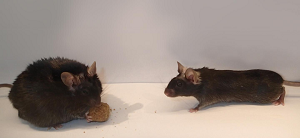 |
| A mouse (left) missing the enzyme OGT eats too much at meal time--Courtesy of Johns Hopkins |
Researchers at Johns Hopkins have sleuthed out a hot target for obesity researchers.
The group started by deleting an enzyme called O-GlcNAc transferase, or OGT, from the brains of mice. Already a known player in a pathway that is involved with insulin, it's also a long-studied target involved in weight control.
After deleting OGT in mice, the rodents quickly developed an insatiable appetite and swelled in size when offered a large amount of food. Limited to a regular diet, they lost weight, indicating that a key signal in the brain needed to hit the switch on a feeling of being full had been turned off by the absence of OGT.
Then the team zeroed in on nerve cells in the hypothalamic paraventricular nucleus (PVN), noting that an absence of OGT in the region played a significant role in the process. When they added light-sensitive proteins and activated them with a light beam, the mice went back to their usual diet, suggesting that the enzyme played a crucial role in switching the nerve cells on and off.
The group also observed that glucose levels appear to play a big role in triggering OGT activity.
"There are still many things about this system that we don't know," says grad student Olof Lagerlöf, "but we think that glucose works with OGT in these cells to control 'portion size' for the mice. We believe we have found a new receiver of information that directly affects brain activity and feeding behavior, and if our findings bear out in other animals, including people, they may advance the search for drugs or other means of controlling appetites."
- here's the release